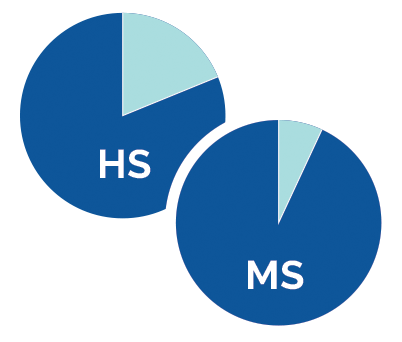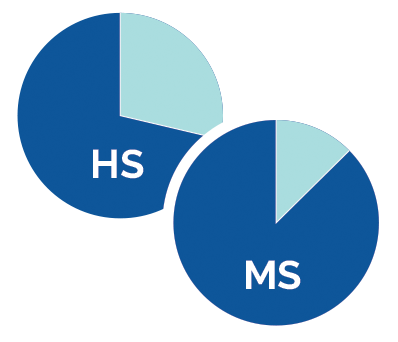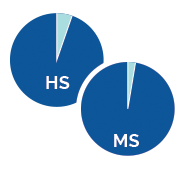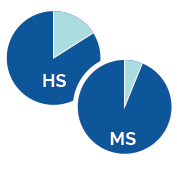Many people think that the only people harmed by tobacco and nicotine use are smokers who have smoked for a long time. The fact is that tobacco and nicotine use can be harmful to everyone. This includes unborn babies and people who don't smoke.
If you smoke cigarettes, cigars, or pipes, or use (vape) e-cigarettes or use smokeless tobacco, such as chew or snuff, the best thing you can do for yourself and for everyone around you is to quit.
How Many Youth are Using Tobacco?
 | 20.1% of ND High school students and 8.9% of ND Middle School students who ever smoked a cigarette. |  | 31.6% of ND High School students and 14.5% of Middle School students have reported using an electronic vaping product. | |
 | 5.4% of ND High School students and 2.6% of ND Middle School students who currently smoke. |  | 18.2% of ND High School students and 7.6% of ND Middle School students report they are currently using an electronic vaping product. | |
| Source: ND YRBS, 2023 | ||||
Before You Talk to your Child
Know the Facts
There are no safe tobacco products. This includes cigarettes, cigars, smokeless tobacco, heated tobacco, hookah, nicotine pouches, and e-cigarettes.
Put Yourself in Their Shoes
Understand the pressure they may face and why they might be curious about vaping or smoking.
Take an Open and Calm Approach
Avoid lecturing or scaring them. Focus on listening and being supportive.
Find the Right Time and Place
Choose a relaxed, low-pressure moment, like while cooking together or in the car where eye contact isn’t required.
Practice the Conversation
Rehearse how you might respond to different questions or reactions.
While You’re Talking
Acknowledge Their Independence
Respect their opinions and listen without judgment.
Ask for Their Perspective
Open the conversation with questions like:
- “Do you know what vaping is?
- “Do kids at your school vape?”
- “Have you ever felt pressured to vape?”
Avoid Scare Tactics
Focus on facts and health impacts rather than fear.
Connect With What They Care About
Discuss how vaping affects things they value, like sports performance or saving money.
Blame Big Tobacco, Not Your Child
Explain how companies target youth with candy flavors and attractive packaging.
After You Talk to your Child
Say Thank You
Acknowledge their openness and thank them for the conversation.
Help Them Manage Stress and Peer Pressure
Offer strategies for handling tough social situations. Be their excuse to leave a pressured situation by allowing them to text you for a quick exit.
Follow Up
Keep the conversation going with short, frequent discussions.
Stay Informed
Keep up-to-date with new trends in vaping and tobacco products.
Look. Listen. Love.
Be present for your child. Your support makes a difference.
The Dangers of Alternative Forms of Tobacco
When it comes to tobacco, cigarettes aren’t the only concern. Alternative forms of tobacco, such as e-cigarettes (vapes), hookahs, smokeless tobacco (chewing tobacco, snuff, snus), and dissolvable products, are often marketed as safer choices. But the reality is, they carry serious health risks.
Vaping and E-Cigarettes
E-cigarettes contain addictive nicotine and harmful chemicals that can damage the lungs and heart. The aerosol isn’t harmless—it's filled with toxic substances.
Hookahs
Hookah smoke contains nicotine, carbon monoxide, and cancer-causing chemicals. A single session can expose users to more smoke than cigarettes, increasing risks of cancer, heart disease, and lung issues.
Smokeless Tobacco
Chewing tobacco, snuff, and snus contain cancer-causing chemicals and increase the risk of oral cancer, gum disease, tooth decay, and nicotine addiction.
Dissolvable Tobacco Products
These products deliver nicotine by dissolving in the mouth, posing risks of nicotine poisoning, addiction, and other health issues.
Bottom Line
No form of tobacco is safe. Educate yourself and your family about the risks associated with all types of tobacco. Look. Listen. Love. Be present, and help guide your loved ones toward healthier choices.
